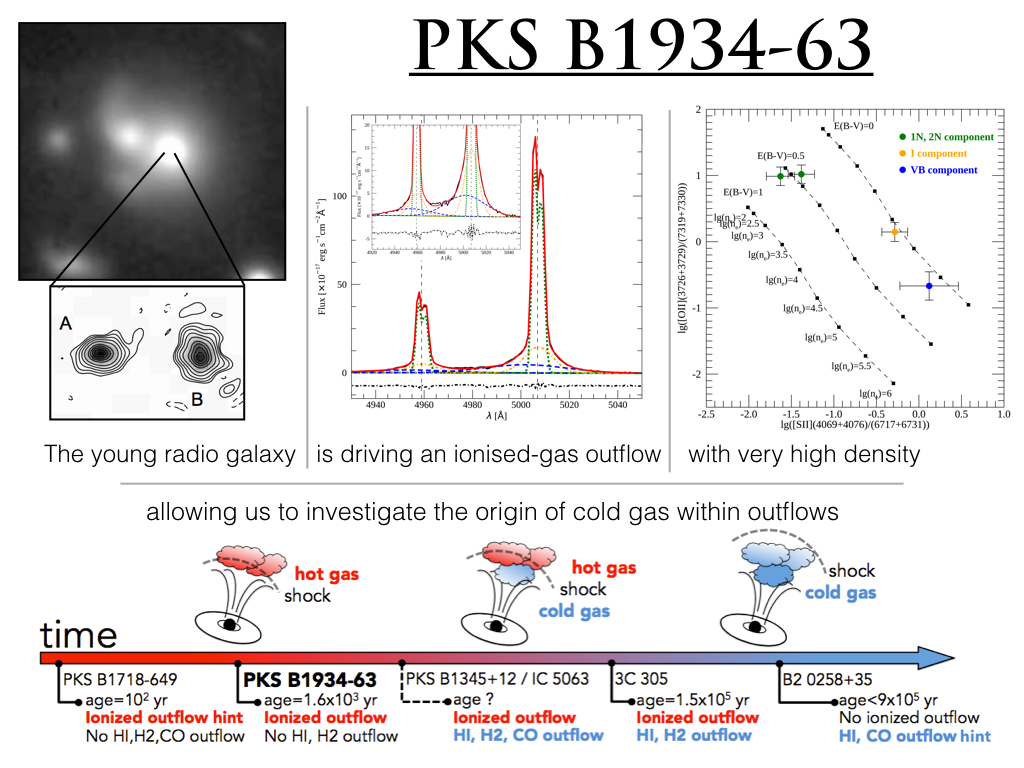Daily Image
26-07-2018The jet-driven outflow in the young radio galaxy PKS B1934-63: one more piece in the puzzle of cold gas formation.
| Submitter: | Francesco Santoro |
| Description: | It is well known that the energy released by an Active Galactic Nucleus (AGN) is able to disturb the host galaxy's interstellar medium (ISM) deeply influencing the evolution of the host galaxy. The interaction between the energy released by the AGN and the ISM is particularly prominent in compact and young radio galaxies, and one of its main manifestations are jet-driven gas outflows. Compact radio galaxies are newly-born radio sources that are expanding within the ISM of they host galaxies. Many compact radio galaxies show clear signs of the interaction between the expanding radio jets and the surrounding dense, and multi-phase, ISM which slows down (or even prevents) the jet expansion. These newly-born AGN inflating their radio lobes into the surrounding ISM give us the unique opportunity to study many aspects of so-called AGN feedback. We studied the ISM in the nuclear region of the galaxy hosting the compact and young radio source PKSB 1934-63 (in the upper left figure) using X-shooter observations. Most of the warm ionized gas resides within a circum-nuclear disk with a radius of about 200 pc that is likely to constitute the gas reservoir from which the central black hole feeds. On the other hand, we find a bi-conical outflow of warm ionized gas that is likely driven by the expansion of the radio jets (you can see the signs of outflowing gas in the blueshifted wing of the [OIII] emission line in the central figure). Thanks to the superior wavelength coverage of the X-shooter data we could estimate the density of the gas in a more accurate way by using a more refined technique (the new diagnostic diagram we used is shown in the upper right figure). We find that the outflowing gas has remarkably high density and the AGN feedback is operating at relatively low efficiency. In addition, optical and near-IR line ratios show that the expansion of the radio source is driving fast shocks which ionize and accelerate the outflowing gas. At odds with the properties of other compact and young radio sources hosting warm ionized gas outflows, we do not find signs of kinematically disturbed or outflowing gas in phases colder than the warm ionized gas. We argue that this is due to the young age of our source, and thus the recent nature of the AGN-ISM interaction, and suggest that cold gas forms within the outflowing material and the shock-ionized outflowing gas of PKS B1934-63 did not have enough time to cool down, and accumulate in a colder phase. Last but not least, we tried to test this scenario explaining the origin of cold gas in outflows by using the information on other compact and young radio sources from the literature. As shown in the timeline in the bottom part of this daily image, this scenario is supported by the multi-phase outflows of other compact and young radio sources in the literature. Our work has been recently accepted for publication in A&A, you can read more about it in the paper at this link: https://arxiv.org/abs/1806.09461 |
| Copyright: | Francesco Santoro |
| Tweet |  |
